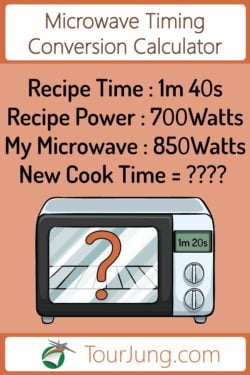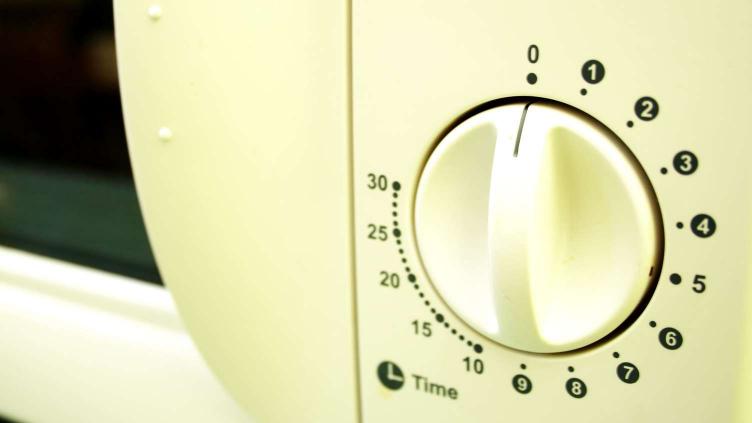Times change and so does technology which includes the power of microwaves which is why you need this handy microwave timing converter.
If you have old recipe books or hand me down recipes from your mum (or maybe even grandma), then the chances are the microwave timings for those old recipes will be for an older microwave model which is significantly less powered than the one sitting in your kitchen.
Microwave Timing Conversion Calulator
You probably don’t need written instructions but if the operation is not clear then please check out the How to Easily Convert section below – jump there from the table of contents above.
You can enter recipe timings in minutes and seconds or just in seconds (in which case do not enter anything at all in the Minutes field). Conversions are rounded to the nearest 5 seconds for convenience which is fine for any microwave recipe.
Why Microwave Recipes Need Time Conversion
A microwave creates microwaves of differing strength depending on the power of the magnetron which creates them. The waves are bounced off a metal reflective fan which disperses them into the food that heats up at a rate proportional to the power of the microwave. So a microwave recipe for a microwave of a given power will need to be retimed for a microwave of different power.
Not so long in the past, about 70 years ago actually, microwaves were not even imagined. A melting peanut cluster bar in an engineers pocket led to the creation of this technology marvel so many people have in their kitchens.
But the first kitchen microwaves were not the same as the ones we have today being quite a bit lower powered, gradually increasing in power as technology moves on.
So we have some people using old microwaves with a maximum power rating of say, 600W and other people with later older models with power ratings of 700W or 750W and nowadays the more common 850W or 1100W or even 1200W ovens.
Then there is the additional problem of recipes designed for the modern microwave appliance of the 80’s and the power ratings available in those times, to modern recipes with higher ratings.
Even today, microwaves are sold with quite different power ratings so even a new microwave may not be the same rating as needed for the recipe you are reading.
Now food is heated by microwaves at a rate roughly proportionate to the power output of the microwave and so if the microwave and recipe do not match then you will need to adjust the time of cooking for the same result.
Some microwaves offer multiple power rating outputs through their settings and so you may be able to adjust your particular machine to match the recipe but if not then you will need to convert the time. Which is where we come in with this handy microwave conversion chart.
How to Calculate Recipe Timings for Different Powered Microwaves
The timing recalculation is not very complicated and is simply a proportional mathematical calculation based on the relative powers of the recipe and your own microwave.
Scientifically the conversion is not exactly proportional but when you are cooking with a microwave or even on a stove. In a microwave, the food is heated up by the microwaves unevenly anyway (which is why you turn the food during microwaving) and it is cooked both by the action of the microwaves on the food molecules as well as heat conduction through the food. So proportional approximation is all that you need to worry about to recalculate your recipe timings to match.
Another use for the conversion chart is to adjust timings to try out different microwave power settings – cooking food for longer at a lower setting or for a shorter time at a higher given setting. Most people may not bother but you can use the microwave conversion calculator to get timings if you want to experiment too.
Information You Need to Use Our Microwave Timing Conversion Calculator
You simply need three pieces of information:
- Power of the Microwave the recipe is based on
- Length of Time given in the recipe
- Power of Your Microwave (or power setting you intend to use)
If there is no sticker on your microwave check the instructions or look online for the specifications of your machine – you’ll likely only have to do it once and will remember from then on.
How to Easily Convert Microwave Cooking Times
Step 1 – Enter the Cooking Time from the Recipe in the Recipe Timing (Minutes) and Recipe Timing (Seconds) Fields in the form below.
Step 2 – Enter the Microwave Power Stated in the Recipe in the Recipe Microwave Power Field in the form Below
Step 3 – Enter the Power of Your Microwave in the My Microwave Power Field in the form below.
Step 4 – Read off the Recalculated Timing for the recipe with your microwave in the Recalculated Time Fields in the form below. Note: Recalculated Timings are always given in Minutes and Seconds.
You can either enter recipe cooking times in Minutes and Seconds in the matching form fields or just enter seconds in the seconds field if not more than 120 seconds.
For example, a recipe calls for 90 seconds using a 750W oven and you have an 850W oven. Do not enter anything in the Recipe Minutes field. Enter 90 in the Recipe Seconds Field, set the Recipe Power to 750 and the My Microwave Power Field to 850 using the drop down menus. Read off the new timings that are shown.
Another example. A Recipe calls for 5 minutes cooking time at 850W and you have a 600W oven. Enter 5 in the Recipe Minutes field and do not enter anything in the seconds field. Set the drop down for Recipe Power to 850 and the drop down for My Microwave Power to 600 and read off the new microwave cooking time from new timings shown.

